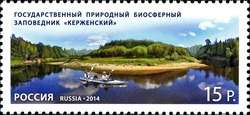Kerzhenets Nature Reserve
| Kerzhinski Nature Reserve | |
|---|---|
|
Russian: Керженский заповедник (Also: Kerzhensky) | |
|
IUCN category Ia (strict nature reserve) | |
|
Kerzhinski Zapovednik | |
 Location of Reserve | |
| Location | Nizhny Novgorod Oblast |
| Nearest city | Nizhny Novgorod |
| Coordinates | 56°37′0″N 44°16′0″E / 56.61667°N 44.26667°ECoordinates: 56°37′0″N 44°16′0″E / 56.61667°N 44.26667°E |
| Area | 46,940 hectares (116,000 acres) |
| Established | 1993 |
| Governing body | FGBI State Biosphere Reserve Taz |
| Website | http://www.kerzhenskiy.ru/ |
Kerzhinski Nature Reserve (Russian: Керженский) (also Kerzhensky) is a Russian 'zapovednik' (strict nature reserve) located in the middle basin of the Kerzhenets River (a left-bank tributary of the Volga), 600 kilometres (370 mi) east of Moscow. The terrain features extensive upland and lowland swamps, and is known in particular as a site for the study of beavers, and their effects on recovery of the landscape after fires and logging. The reserve is situated 55 km northeast of the City of Nizhny Novgorod in the Bor and Semonov districts of Nizhny Novgorod Oblast. The site has been a center for scientific study of nature of the region since 1933. It is part of a UNESCO Biosphere Reserves, Ramsar wetland. The reserve was established in its current form in 1993, and covers an area of 46,940 ha (181.2 sq mi).[1][2]
Topography
The reserve is roughly 25 km across, and 40 km north of the Volga as it flows due east at this point. The north and west half of the reserve are forested, and the south and east are riverine wetlands. 80% of the territory is in the lowlands of the Kerzhenets river basin. The bedrock is Permian clay, marl and limestone overlain by 5 to 30 meters of alluvial sediments. The banks of the tributaries of the Kerzhenet are marked by outcrops of carbonate rocks.[1]
Climate and Ecoregion
Kerzhinski is located in the Scandinavian and Russian taiga ecoregion. This is situated in Northern Europe between tundra in the north and temperate mixed forests in the south. It is covers parts of Norway, Sweden, Finland and the northern part of European Russia, being the largest ecoregion in Europe. Coniferous forests dominated by Pinus sylvestris (in drier locations), often with an understory ofJuniperus communis, Picea abies and Picea obovata and a significant admixture of Betula pubescens and Betula pendula. Larix sibirica is characteristic of the eastern part of the ecoregion.[3]
The climate of Kerzhinski is Humid continental climate, cool summer (Köppen climate classification (Dfb)). This climate is characterized by large swings in temperature, both diurnially and seasonally, with mild summers and cold, snowy winters.[4] The average January temperature is -12 C, July is 19 C. Annual precipitation averages 550 mm. Winds in the summer are from the northwest, but from the south and west the remainder of the year.[2]
Flora and Fauna
The landscape displays features of Eastern European mixed forest, particularly peat bogs, pine forests (60% of the territory) and alder-birch forests (35% of the reserve) in the lower wetter regions, with associated plants and animals. The remainder of the landscape is swamp and transitional mire. The area was subject to extensive tree loss (to logging and fires, particularly a disastrous fire in 1972 that killed 20% of the trees), so the stands are mostly middle-aged or younger. A recent study of the reserve recorded 103 species of algae, 283 of mushrooms, 205 of lichens, 160 of bryophytes and 593 species of vascular plants.[1][2]

Because the reserve is in a transitional zone on the edges of three regions - taiga, broadleaf forest, and steppe - it has animals that are representative of each. Taiga species include caribou, wolverine and squirrel. Broadleaf forests to the west contribute martens, minks, and wood mice. Steppe species include voles, hedgehogs, and field mice. Throughout are the larger mammals of the woods: wolf, fox, badger, stoat, weasel, and bear.[2] Part of the work of the reserve is experimenting with the re-introduction and recovery of species that have been lost to the territory. Current reintroduction efforts are focused on the muskrat, the Willow ptarmigan, and the forest reindeer.[1]
Ecotourism
As a strict nature reserve, the Kerzhenski Reserve is mostly closed to the general public, although scientists and those with 'environmental education' purposes can make arrangements with park management for visits. There are three main 'ecotourist' routes that have been developed for tourists: a floodplain tour, a swamp tour, and a forest tour. The reserve has also opened a visitor center. The main office is in the town of Rustan.[1]
See also
- List of Russian Nature Reserves (class 1a 'zapovedniks')
- National parks of Russia
- Protected areas of Russia
References
- 1 2 3 4 5 "Kerzhinski Zapovednik (Official Site)" (in Russian). Ministry of Natural Resources and Environment (Russia). Retrieved January 21, 2016.
- 1 2 3 4 "Kerzhinski Zapovednik" (in Russian). Ministry of Natural Resources and Environment (Russia). Retrieved January 21, 2016.
- ↑ "Scandinavian and Russian taiga". Encyclopedia of Earth. Archived from the original on March 4, 2016. Retrieved January 24, 2016.
- ↑ "Climate of Kerzhinski". GloalSpecies.org. Retrieved January 21, 2016.
External links
| Wikimedia Commons has media related to Kerzhensky Nature Reserve. |
